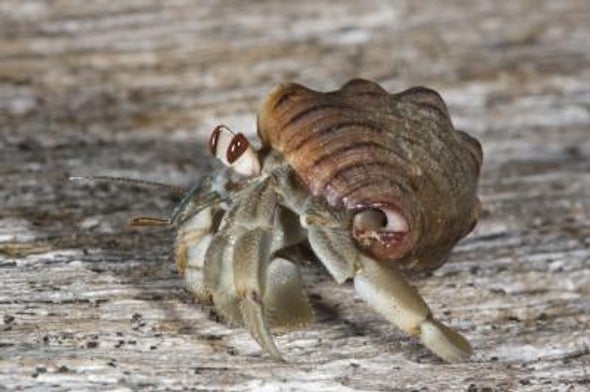This is Scientific American's 60-second Science。 I'm Karen Hopkin.
"So, I never really thought I'd study penis size, but I sorta stumbled on this topic." Mark Laidre, a biologist at Dartmouth College. Laidre travels to Costa Rica to study hermit crabs, a species called Coenobita compressus. These land crabs do some interior remodeling of their adopted shells: they extensively hollow them out, removing struts called spiral columella, to give themselves some extra elbow room. The renovation renders the shells more precious to their owners—and to other covetous crustaceans as well.
"These more valuable shells, though, are also more easily stolen, since without the spiral columella inside the shell to grip onto, individuals are pretty liable to have their property snatched from them. Particularly when they are engaged in other activities, like copulation, which requires coming partway out of the shell."
Despite his work in the field, it wasn't until Laidre was wandering through a museum that he noticed something about his favorite crabs.
"The really striking thing was that Coenobita compressus, the one whose social behavior I'd been studying for so many years, had an unusually large penis. In fact, bigger than any of the other species."

The observation gave him an idea, which he dubbed the "private parts for private property" hypothesis.
"In essence, the hypothesis posits that enlarged private parts can be an adaptation, extending a male's sexual reach and thus enabling both him and his partner to remain safely tucked away inside their shells while they copulate, thereby protecting the private property of their shells from being stolen during sex."
Darwin proposed a similar idea to explain why barnacles, which are stuck in one place, are so amply endowed.
To test his "private parts for private property" hypothesis, Laidre sized up more than 300 male museum specimens, including hermit crabs that live on land and at sea. And he found that crabs that carried custom coverings had the most impressive carnal equipment. At the same time, species that got their shells off-the-shelf had bigger gear than did crabs that walked around with no shell at all. His results are revealed in the Royal Society journal Open Science.
"It's intriguing to think that this hypothesis might have greater generality beyond hermit crabs."
But like a hermit crab encountering a humdrum shell, Laidre says he's gonna leave that one alone.
"For me, I'm much more curious about how forms of animal architecture and remodeling in the environment impact social behavior."
Thanks for listening for Scientific American — 60-Second Science. I'm Karen Hopkin.












